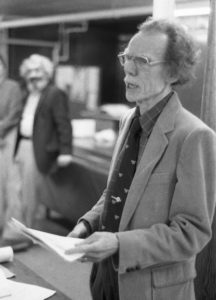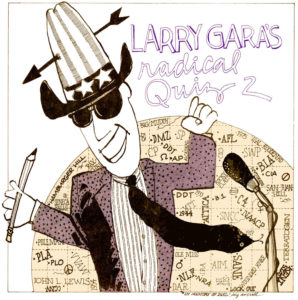In remembrance of Larry Gara
As many readers know, we date the “modern war tax resistance movement” to World War II, when hundreds of amazing people refused to participate with their bodies and/or their taxes. These resisters tended to be committed pacifists, many of them already involved with War Resisters League or the Fellowship of Reconciliation or members of peace churches, such as the Society of Friends.
Larry Gara was one of them. I knew and worked with him during my time on staff at the War Resisters League and was sad to learn of his death at age 97 on November 23. After the war years he became a history professor and retired in 2002 from 40 years of teaching at Wilmington College in Wilmington, Ohio. You can read his resistance and prison story in a lovely book, A Few Small Candles: War Resisters of World War II Tell Their Stories, which Larry co-edited with his wife Lenna Mae Gara, who survives him.
Thinking about all the ways that Larry contributed to war resistance and to War Resisters League, reminded me of the Radical History Quiz he used to write for WRL’s Magazine, The Nonviolent Activist. So, for today’s post I decided to pull out questions from some of his quizzes that appeared in the magazine between 1989 and 2002.
Most of these questions or answers relate to WTR somehow. If the answer is a person, it is usually someone who was a war tax resister, and you can find references to them on NWTRCC’s history pages or on this “Pioneers of the Modern American War Tax Resistance Movement” page collected by David Gross. A few are just good war resistance stories.
Answers are at the bottom of the page.
1. Who was the Quaker pacifist tortured for his refusal to obey orders during the Civil War, and whose wartime diary became a peace classic?
- Cyrus Pringle
- Alfred Love
- William Lloyd Garrison
- Thomas Garrett
2. In 1940, eight theological students refused to register for the first U.S. peacetime draft. Their action was organized by:
- Igal Roodenko
- Devere Allan
- David Dellinger
- Tracy Mygatt
3. An international pacifist community founded in 1940 near Cleveland was called:
- The Bruderhof
- Ahimsa Farm
- The Newark Ashram
- Koinonia
4. Radical pacifist movement, favoring non-registration and war tax resistance was founded in 1947:
- Fellowship of Reconciliation
- Women Strike for Peace
- American Friends Service Committee
- Peacemakers
5. Christian anarchist and self-styled “one man revolution” who picketed the IRS offices each Tax Day and fasted a day for each year that had passed after the bombing of Hiroshima:
- Harold Gray
- Ammon Hennacy
- Scott Nearing
- Ernest Bromley
6. Missionary who was ousted form British-controlled India for supporting the Gandhian independence movement, he also wrote Democracy and Nonviolence:
- Ralph Templin
- Allan Knight Chalmers
- Holmes Smith
- Harry Emerson Fosdick
7. Labelled by Time Magazine as America’s best known pacifist, he had briefly belonged to the Trotskyist Workers Party:
- Norman Thomas
- A.J. Muste
- J. Holmes Smith
- John Nevin Sayre
8. A theater group founded by Julian Beck and Judith Malina and involved with the nonviolent movement was called:
- Bread and Puppet Theater
- New York Mime Theatre
- Greenwich Village Players
- The Living Theater
9. A poet who served time in jail rather than pay a fine for an act of civil disobedience in the Redress demonstration against the Vietnam War was
- Anais Nin
- Sylvia Plath
- Muriel Rukeyser
- Denise Levertov
10. In what song did the Hello People tell of going to prison for war resistance?
- “How does it feel to be free?”
- “This land is your land”
- “Anthem”
- “White Winged Doves”
11. A founder of Peacemakers whose war tax resistance led to the threatened seizure of her land trust home in Cincinnati:
- Marion Bromley
- Barbara Deming
- Marjorie Swann
- Dorothy Day
12. Folksinger/founder of the Institute for the Study of Nonviolence:
- Bernice Reagon
- Judy Collins
- Holly Near
- Joan Baez
13. For which war tax resister(s) did dozens of supporters create a kind of war tax resistance camp in Colrain, Massachusetts, to block IRS efforts to seize a home?
- Wally and Juanita Nelson
- Randy Kehler and Betsy Corner
- Maurice McCracken
- Ernest and Marion Bromley
14. Which celebrated U.S. writer and activist started both careers in Washington Square Park?
- Tillie Olson
- Amiri Baraka
- Grace Paley
- Meridel LeSeuer
15. How much money was redirected in the year 2000 from the Pentagon to progressive causes by “peace tax” funds and individual war tax resisters (according to NWTRCC)?
- $10,000
- $50,000
- $100,000
- $250,000
Bonus Question!
A Prothonotary Warbler plays an important part in the case of:
- Alger Hiss
- the Rosenbergs
- Arthur Miller
- Frederick Remington
(Ok, the bonus question has nothing to do with WTR, but Larry was an avid birdwatcher so I had to throw that in. More on that case…)
— Post by Ruth Benn
Answers: 1 – A; 2 – C; 3 – B; 4 – D; 5 – B; 6 – A; 7 – B; 8 – D; 9 – C; 10 – C; 11 – A; 12 – D; 13 – B; 14 – C; 15 – C; Bonus – A







Larry was a terrific, dedicated, amusing, and very sweet person. His life, as briefly recounted in the WRL obit (linked at the top), is an inspiration to those of us who see war resistance as more than just a job or something to do in our free time.
Sad to say, I only got 10 of the 16 questions. Guess I better refresh my knowledge of radical pacifist history. ; – (
I second all Ed said about Larry. And I got only 9 of the questions right!